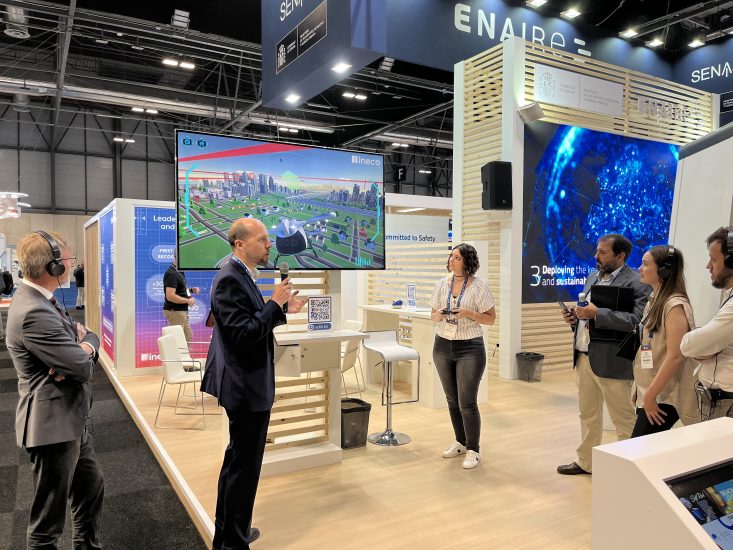By Jenny Beechener
First results from SESAR 2020 U-space research on show at World ATM Congress (WATMC) 2022 in Madrid 21-23 June included, among others, an interactive simulator demonstrating taxi flights on the Ineco stand; separation assurance services in non-segregated airspace on Indra’s uncrewed traffic management (UTM) platform; and detailed representation of a very large-scale demonstration airport taxi flights planned in Frankfurt and the UK later this year at the Droniq stand. The results are encapsulated in the recently published Demonstrating the everyday benefits of U-space brochure.
“[SESAR] live demonstrations are showing how U-space can work to help provide recommendations to the standardisation process,” said Cengiz Ari, SESAR Joint Undertaking U-space programme manager. A key milestone is publication of a fourth U-space Concept of Operations (ConOps) – due in the coming weeks according to Andrew Hately, drone researcher at EUROCONTROL and technical coordinator for SESAR’s ConOps for European UTM Systems eXtension for Urban Air Mobility (CORUS-XUAM) project. “This will be followed by a workshop to obtain feedback, and edition 5 will come in early 2023,” he said. CORUS delivered ConOps edition 3 in 2019, and edition 4 integrates the results of recent research and standards to align with the latest EU regulations.
The SESAR U-space research and innovation programme is helping to define the operational concepts and safety standards that will be necessary for unmanned vehicles to operate in manned airspace. The projects support commercial opportunities in the drone industry such as medical deliveries, surveys, imagery, and first response services. The SESAR Joint Undertaking partners completed a first wave of projects in 2019, followed by this second wave which completes in 2022, ahead of another call for projects currently underway and due to start in 2023 under SESAR 3 JU.
Innovation pipeline
The SESAR solutions provide a stepping-stone towards safe commercial drone operations. Several have already transitioned from demonstration activities to real-life operations in a trial environment, such as the inspection services now permitted in the island city of Tromsø, Norway, within the 5km exclusion zone of Tromsø Airport, on the back of GOF2.0 demonstrations showing contingency services working in a real dynamic environment. Similarly, a medical delivery beyond visual line of sight (BVLOS) between hospitals received authorisation in Belgium over a populated area for the first time in June 2022 as a result of the SAFIR-Med Very Large-scale Demonstration (VLD) in which networks of hospitals and laboratories use drones to shuttle medical samples and tissue using pre-defined corridors.
“The authorisation was the outcome of three years’ working with regulators and operators,” said Mikael Shamim, Helicus CEO and SAFIR-Med project lead at WATMC 2022. “It is not yet viable commercially but this shows it can be done and we can start to gain experience.” The project includes a central command and control centre that manages flight authorisations in addition to tactical conflict detection capabilities as part of a “swiss cheese safety model”.
Many more demonstrations will take place in the second half of 2022, testing different solutions and different applications. For example, under the Uspace4UAM project, electric Vertical Take Off and Landing (eVTOL) demonstration days are scheduled in Czech Republic, Poland, Spain and the UK to test higher levels of automaton. The project will help to progress towards an internationally acceptable concept of operations, which is a key prerequisite for safe integration of UAM in U-space and traditional air traffic.
U-space architecture
In a separate project, AMU-LED VLD is testing two different U-space architectures and conducting seven demonstration flights in the UK, Netherlands and Spain this year. “We have developed a safety assessment methodology for UAM and use case scenarios for each demonstration. We are testing centralised and de-centralised U-space architectures and have created an operational framework including the technical aspects,” said Pablo Menéndez-Ponte Alonso, NTT Data project leader at the SESAR U-space panel.
Another project examining target levels of safety, BUBBLES is defining the basic building blocks for a U-space separation management service. The exploratory research project has carried out multiple flights in a rural area north of Valencia to test separation management concepts, delivered as a centralised service. Safety levels were raised according to operational risk in order to provide acceptable levels of safety based on separation minima, vertical threshold, effectiveness of different mitigation barriers and the number of safety layers. BUBBLES has defined a set of safety performance requirements needed to guarantee the required effectiveness of the safety barriers which was exhibited as part of Indra’s UTM platform.
Standards development
Results from the SESAR U-space projects, along with lessons learned along the way, inform standards development by the European Aviation Safety Agency (EASA) and national regulatory bodies. The findings provide valuable input to accelerate development of a U-space framework.
The commercial drone industry has expanded significantly since EU Implementing Regulation (IR) 2019/947 established the first rules for U-space setting out basic U1 services. The more recent EU IR 2021/664 builds on 2019/947 and regulates the minimum services for initial U2. As the industry continues to evolve, additional U-space functions are being developed, with the regulatory framework eventually expected to include U3 and U4 services. SESAR U-space research projects are an important part of the process of defining which services will be needed and the performance requirements necessary for each to meet safety standards.
For more information about SESAR U-space solutions, visit www.sesarju.eu/u-space
Image: The SESAR walking tour stops by the ENAIRE stand where the AMU-LED project addresses critical communications, surveillance and tracking of drone operations in urban environments.
For more information visit:




